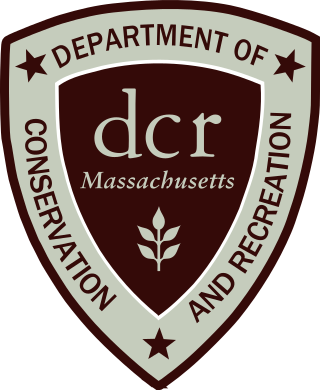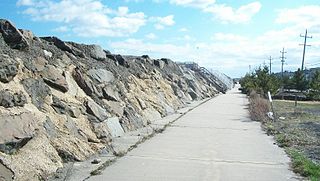
Winthrop is a town in Suffolk County, Massachusetts, United States. The population was 19,316 at the 2020 census. Winthrop is an ocean-side suburban community in Greater Boston situated at the north entrance to Boston Harbor, close to Logan International Airport. It is located on a peninsula, 1.6 square miles (4.2 km2) in area, connected to Revere by a narrow isthmus and to multiple portions of Boston by a bridge over the harbor inlet to the Belle Isle Marsh Reservation in the Neighborhood of East Boston, a shared border at the Boston Logan International Airport, and at Deer Island.

Beach nourishment describes a process by which sediment, usually sand, lost through longshore drift or erosion is replaced from other sources. A wider beach can reduce storm damage to coastal structures by dissipating energy across the surf zone, protecting upland structures and infrastructure from storm surges, tsunamis and unusually high tides. Beach nourishment is typically part of a larger integrated coastal zone management aimed at coastal defense. Nourishment is typically a repetitive process since it does not remove the physical forces that cause erosion but simply mitigates their effects.

The Boston, Revere Beach and Lynn Railroad was a 3 ft narrow-gauge passenger-carrying shortline railroad between East Boston and Lynn, Massachusetts, from 1875 to 1940. Part of the railroad's right of way now forms the outer section of the Massachusetts Bay Transportation Authority's Blue Line rapid transit service.

The Department of Conservation and Recreation (DCR) is a state agency of the Commonwealth of Massachusetts, United States, situated in the Executive Office of Energy and Environmental Affairs. It is best known for its parks and parkways. The DCR's mission is "To protect, promote and enhance our common wealth of natural, cultural and recreational resources for the well-being of all." The agency is the largest landowner in Massachusetts.

Revere Beach is a public beach in Revere, Massachusetts, measuring over three miles (4.8 km) long and located about five miles (8 km) north of downtown Boston. In 1875, a rail link was constructed to the beach, leading to its increasing popularity as a summer recreation area, and in 1896, it became the first public beach in the United States. It is still easily accessible from Boston by the MBTA subway's Blue Line, and can accommodate as many as one million visitors in a weekend during its annual sand sculpture competition. The Revere Beach Reservation and Revere Beach Reservation Historic District is listed on the National Register of Historic Places.

Belle Isle Marsh Reservation in East Boston, Suffolk County, Massachusetts is an urban nature preserve and public recreation area containing mostly coastal wetlands. The 350-acre (1.4 km2) Reservation includes the largest remaining salt marsh in the Boston area. The marsh also borders the towns of Revere and Winthrop.

Salisbury Beach State Reservation is a state-owned, public recreation area on the Atlantic Ocean in the town of Salisbury, Massachusetts, managed by the Massachusetts Department of Conservation and Recreation. It is one of the most heavily utilized state parks in the Commonwealth, with "an annual attendance rate of over one million visitors."
Beach evolution occurs at the shoreline where sea, lake or river water is eroding the land. Beaches exist where sand accumulated from centuries-old, recurrent processes that erode rocky and sedimentary material into sand deposits. River deltas deposit silt from upriver, accreting at the river's outlet to extend lake or ocean shorelines. Catastrophic events such as tsunamis, hurricanes, and storm surges accelerate beach erosion.

Wollaston Beach is the largest public beach in the Boston Harbor. The beach is located parallel to Quincy Shore Drive in North Quincy, Massachusetts, which was constructed to provide access to the bay beach for Greater Boston. Wollaston beach expands Quincy Bay forming part of Boston Harbor. The northern end of the beach is the Native American historical site, Moswetuset Hummock which is where the original Moswetuset Sac'hem (Chief) had a tribal council.

Winthrop Parkway is a historic parkway in Revere, Massachusetts. The parkway, built between 1909 and 1919 and now designated as part of Route 145, runs for about 0.75 miles (1.21 km), from Eliot Circle southeast to the Revere-Winthrop line. Acquisitions for its construction represent the last public purchase of oceanfront lands in Revere. It was listed on the National Register of Historic Places in 2004.

Winthrop Shore Drive is a historic parkway in Winthrop, Massachusetts. The mile-long parkway runs through the Winthrop Beach Reservation, and is administered by the Massachusetts Department of Conservation and Recreation (DCR). The parkway is one of a series of ocean parkways that make up a network of parkways connecting major open spaces in the Greater Boston area. Both the parkway and reservation were designed in the mid-1890s by Charles Eliot for the Metropolitan Parks Commission, a predecessor to the DCR. Land was acquired for the parkway in 1899, and construction was largely completed in 1900.

Nahant Beach Boulevard, also Nahant Causeway and Nahant Road, is a historic road on the isthmus connecting Nahant, Massachusetts to the mainland at Lynn, Massachusetts, United States. The road runs from the Lynn Rotary, its junction with Lynn Shore Drive and the Lynnway, about 1.5 miles (2.4 km) to Wilson Road in Nahant. It passes through Nahant Beach Reservation, a state park offering beach access on the isthmus. The road offers expansive views of the area coastlines and Boston Harbor. Both the park and the roadway are administered by the Massachusetts Department of Conservation and Recreation.

Scusset Beach State Reservation is a state-operated, public recreation area located in the town of Sandwich in Barnstable County, Massachusetts, at the east end of the Cape Cod Canal on land formerly part of Sagamore Hill Military Reservation. In addition to its beach and campgrounds, prominent features of the park include Sagamore Hill, a one-time Native American meeting ground and site of World War II coastal fortifications, and a 3,000-foot (910 m) stone jetty that separates the canal and beach. Unlike most of Sandwich, this section of the town is on the mainland side of the Cape Cod Canal. The state park is managed by the Massachusetts Department of Conservation and Recreation under a lease agreement with the U.S. Army Corps of Engineers.

The Metropolitan Park System of Greater Boston is a system of reservations, parks, parkways and roads under the control of the Massachusetts Department of Conservation and Recreation (DCR) in and around Boston that has been in existence for over a century. The title is used by the DCR to describe the areas collectively: "As a whole, the Metropolitan Park System is currently eligible for listing on the National Register of Historic Places", as outlined on the department's website. The DCR maintains a separate Urban Parks and Recreation division to oversee the system, one of five such divisions within the department—DCR's Bureau of State Parks and Recreation manages the remainder of Massachusetts state parks. Direct design and maintenance functions for the parkways and roads within the system are provided by the DCR Bureau of Engineering.

Quincy Shore Reservation is a public recreation area and protected shoreline on Quincy Bay, Boston Harbor, in Quincy, Massachusetts. Its primary attraction is a 2.3-mile-long (3.7 km) beach, accessible along its entire length by Quincy Shore Drive. The largest beach on Boston Harbor, it is known locally as Wollaston Beach, named for the adjacent Wollaston neighborhood.

Lynn Shore Reservation is a protected coastal reservation in the city of Lynn, Massachusetts. It includes 22 acres (8.9 ha) of beaches and recreational areas. From north to south, King's Beach, Red Rock Park and Lynn Beach are located along Lynn Shore Drive and Nahant Bay, a small bay of the Atlantic. The reservation shares athletic fields with Nahant Beach Reservation in the area around Nahant Rotary, a traffic circle at its southern end.

Nahant Beach Reservation is a protected coastal reservation covering 67 acres (27 ha) of beach and recreational areas in the town of Nahant, Massachusetts. Nahant Road, formerly known as Nahant Beach Boulevard when it was added to the National Register of Historic Places in 2003, offers access to 7,000-foot-long (2,100 m) Long Beach on the Atlantic Ocean side to the east. The reservation includes a boat ramp with access to Lynn Harbor and shares athletic fields with Lynn Shore Reservation in the area around Nahant Rotary, a traffic circle at the reservation's northern end. The reservation is part of the Metropolitan Park System of Greater Boston.

Route 16 is a 59.8646-mile-long (96.3427 km) east–west state highway in Massachusetts. It begins in the west at an intersection with Route 12 and Route 193 in Webster, just north of the Connecticut state border. It runs in a generally southwest-northeast routing through a number of Boston's suburbs and runs to the west and then north of the city before ending in Revere at an intersection with Route 1A and Route 60.

Lynn Shore Drive is an historic oceanfront parkway in Lynn, Massachusetts, United States. Composed of a two-lane road, parkland, a seaside pedestrian esplanade, and a seawall, Lynn Shore Drive runs for approximately one mile (1.6 km) along Lynn's Atlantic Ocean coastline, following the upland boundary of the adjoining Lynn Shore Reservation, and connecting Nahant with Swampscott.

The Sea Bright–Monmouth Beach Seawall is a seawall located along the Jersey Shore in the Monmouth County, New Jersey towns of Sea Bright and Monmouth Beach. It roughly runs north-south direction along 4.7 miles (7.6 km) of the barrier spit of land along the lower Sandy Hook peninsula between the Atlantic Ocean and the Shrewsbury River estuary. The use of seawalls, groins, jetties, bulkheads, revetment, and beach nourishment since the late 1800s has made the stretch of coast one of the most heavily engineered sections of ocean shorefront in the world.




















